Admired from Nevers to Carlisle
As my grandfather’s Ford 8 made its intrepid conquest of the 7,000ft high Pyrenean pass of Col de Tourmalet during the return trip from Gibraltar to Carlisle, we fell upon the Gascon language of France’s southwestern region of Gascony. A vernacular of Romance, we learned this tongue to be a variety of Occitan. Tourmalet, therefore, didn’t translate to ‘bad journey’ but rather as ‘long mountain’.
In this episode of Nostalgia Album, we encounter a remarkable young woman who was a native Occitan speaker and who didn’t learn French until taught in school after age thirteen. In a remarkable coincidence, providing further proof that God exists, as we speak (and despite having been born in 1844) the admired mademoiselle is making her way, not quite from Kiev, but from Nevers to Carlisle. How so? As if called upon to fill a never-ending silence following a Liz Truss ‘Kiev to Carlisle’ punchline, allow me to explain.
Bernadette Soubirous was born in Lourdes on 7th January 1844. Puffins may have guessed a visit to Lourdes as the reason for this Pyrenean detour following last week’s port of call at the natural coliseum of Cirque d’Garvarni, the source of the river Gave.
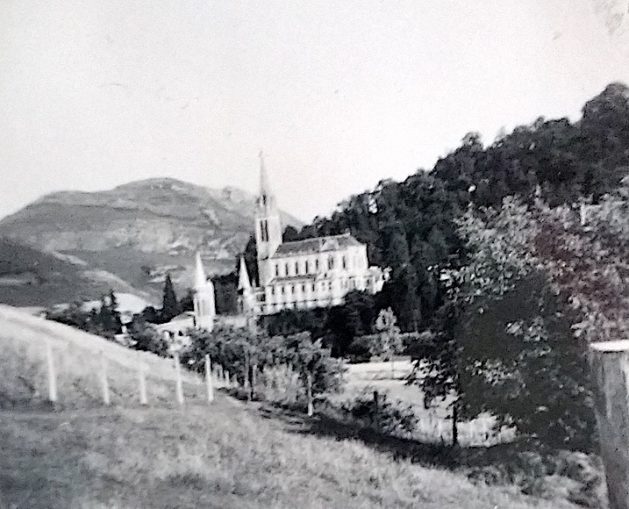
© Always Worth Saying 2022, Going Postal
This week we’re heading north again and are following the Gave to Lourdes. As we’ve observed previously, my grandmother Edith was a sickly soul pictured frighteningly thin with near emaciated arms and legs, shadows about the eyes and gaunt cheeks. Unbeknown at the time, she would die in the following decade, aged only 56.
One does have to wonder at the wisdom of taking her a couple of thousand miles in an old jalopy through boiling hot central Spain and across the freezing cold Pyrenees. No doubt some bracing mountain air and the balmy beaches of Biarritz and southern Spain will have been therapeutic. Likewise, a stopover in Lourdes might be good for morale and fortify the soul.
Bernadette Soubirous
Speaking of sickly souls, back in the mid-nineteenth century Bernadette Soubirous survived cholera as child, suffered asthma all her life and grew to be only 4′ 7″ tall. The eldest of nine children, her father was a miller, her mother a laundress. As time passed the family’s situation worsened and by her early teens the Soubirous were living in one basement room by the charity of a relative with M. Soubirous reduced to working as a day labourer.
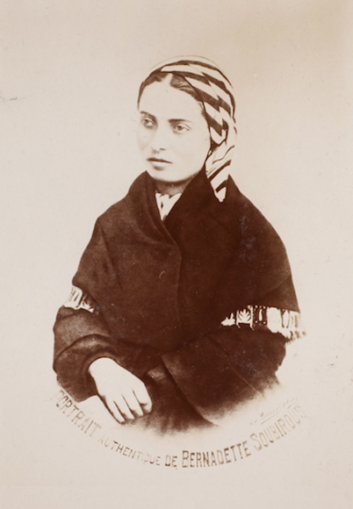
Lourdes Portrait of Bernadette Soubirous,
Photographer unknown – Licence CC BY-SA 4.0
On February 11th 1858, aged 14, while gathering firewood with other girls near the Grotto of Massabielle beside the river Gave, Bernadette experienced an apparition of the Virgin Mary. Within weeks, the news had spread around the world. The Dublin Evening Mail of Friday March 12th 1858 explained,
A considerable agitation has been of late manifested in the neighbourhood of Lourdes, by a visit which a young girl of 14, named Bernadotte Savi, the daughter of a day labourer, pays every morning to a grotto, in which springs forth a gush of water forming a rivulet, not far from the banks of the Gave. This girl affirms that the Virgin Mary has appeared to her, and ordered that she should every morning, for a fortnight, pray in the grotto during the space of half an hour. A vast number of persons accompany her in her visits, believing fully her assertion. At first, when she kneels down, she is represented as being pale, and almost convulsed; but as her communication with the virgin proceeds, her features become calm and radiant. We understand that not less than 5,000 persons are present now each morning near the grotto, and that the authorities are beginning to disapprove of such assemblages.
By May disapproval had spread to the local Prefect who ordered offerings placed in the grotto to be removed by the police. People who saw visions would be sent to hospital in nearby Tarbes for medical treatment. Those who spread ‘absurd tales of heavenly visitation’ would be prosecuted for propagating false news. Sounds familiar.
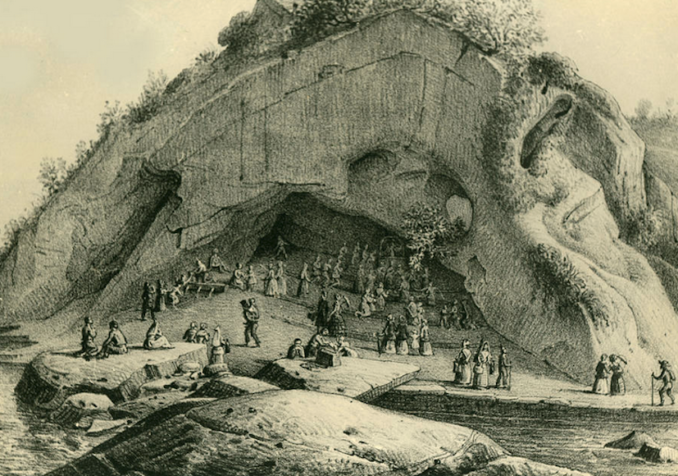
The Grotto of Massabielle a few months after the visions,
Unknown artist – Public domain
The Paris correspondent of The Globe was even snottier, referring to the miraculous events as a ‘silly girls nympholepsy’. He prophesied the upshot of all this would be lots of pilgrims, the opening of a public house, the sale of holy water warranted to cure complaints, the sale of medals representing the girl and her visions, and the glorification of an out-o’-the-way village. A century and a half later, although currently no doubt burning in hell, one must concede the Globe’s cynical old Absinthe-soaked hack did have a point.
By 1862 the authorities had been worn down like the grassy bank of a remote riverside swarming with pilgrims. In that year the Catholic Church confirmed the authenticity of the apparitions with chapels and churches subsequently springing up around the previously down-at-heel Pyrenean town. At this time, wary of the attention she was attracting, Bernadette had moved to a hospice school run by the Sisters of Charity in Nevers over 400 miles away. There she learned to read and write, became a postulant sister as Marie-Barnard and worked as an infirmary assistant and embroiderer of altar cloths and vestments. Always a poorly woman, as well as asthma and cholera she also suffered from tuberculosis and a tubercular tumour of the knee. She died in Nevers in April 1879, aged only 35.
St Bernadette
Three decades later, as part of the canonisation process, Bernadette’s body had to be identified in accordance with both civil and church law to verify the state of her corpse. It was in 1622 that Pope Gregory XV introduced a new standard for vetting the potentially holy. The corpses of prospective saints must undergo a medical involving a posthumous examination and full autopsy. A medical expert is required as a witness to verify bodily sanctity.
I’m not quite sure why.
Curious High Church Puffins with an IQ north of 200 might attempt to scale Pious Postmortems. Anatomy, Sanctity, and the Catholic Church in Early Modern Europe by Bradford A Bouley. Although there is mirth to be had from Mr Bouley’s great work’s status as the 2,252,107th most popular book on Amazon, for once one hesitates, given the subject matter, to compare sales to the Marquis de Sade’s 120 Days of Sodom.
Wary of the superstition surrounding Bernadette, at the time of her death her body had been put on public display for three days before being sealed in a coffin of lead and oak witnessed by an Inspector of the Peace and two constables. Her remains had not been embalmed or preserved. Her coffin was buried in a crypt within a small chapel inside the confines of the convent of the Sisters of Charity in Nevers after a simple ceremony.
In keeping with the instructions of Pope Gregory XV, her body was exhumed on September 22nd 1909 at 8:30 am in the presence of the Bishop of Nevers and Mother Superior and her deputy. Also present were two doctors, two stonemasons and two carpenters, the Mayor and the Deputy Mayor. Bernadette’s vault was opened and the coffin carried to a pre-prepared room where it was placed across two cloth-covered trestles next to another cloth-covered table where Bernadette’s bones were to be placed. The carpenters and masons opened the wooden and lead coffins and as they did so the assembled dignitaries and humble workmen were astonished to observe a body in a state of perfect preservation – with not the trace of an unpleasant smell – as if the previous three decades had never taken place.
The surgeon and doctor, M. Ch. David and M. A. Jourdan, conducted their examination subsequently commenting in their written report upon perfectly preserved hair and nails, hands still clutching a rosary, skin still clinging to muscles and muscle still adhering to bone. Bernadette’s hair was still stuck to her head and attached to the skull. Her ears were perfectly preserved. By 5:30 pm all formalities had been completed. Nuns having washed the body and placed it in a new coffin lined in zinc and padded with silk, Bernadette was returned to her vault.
The canonisation process was interrupted by the Great War with a new Bishop of Nevers in 1918 requiring another identification of the body. The high and mighty gathered again with the medical examination being carried out by two different doctors who wrote their reports separately to avoid any accusations of collision. The reports did agree that the body was still preserved, however, it now showed the superficial effects of mildew presumed to be caused by the washing of 1909.
Bernadette was returned to her crypt again but exhumed once more in 1925 so that relics might be taken. She was eventually canonised in 1933 with her remains (now those of Saint Bernadette of Lourdes) to this day resting inside a glass and bronze reliquary in the Sacred Heart chapel of her old convent, the Saint-Gildard, Nevers.
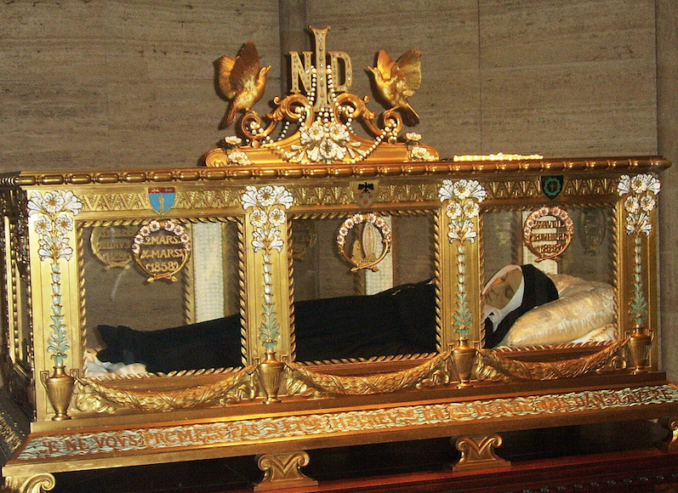
Bernadette Soubirous – sarcophagus in Nevers,
Roock – Licence CC BY-SA 3.0
Plot spoiler. What you can see isn’t St Bernadette’s face but a wax mask made from a mould of her face and then sculptured and coloured with the help of old photographs. Speaking of masks and St Bernadette and as further proof that Mamon exists as well as God, there is such a thing as a £10 St Bernadette covid face mask.
St Bernadette Relic Tour 2022
As I type, St Bernadette’s relics (not her whole body, just the relics recovered in 1925) are touring England and will be in my own parish church later this month. If you’d like to see the relics when they are displayed near you, a helpful infographic showing the itinerary is available here. [https://stbernadette.org.uk/registration/]
As for my own family’s tour in 1952, you’ll be pleased to hear that they took some photos for us to look at next time. Miss AWS, as well as visiting Spanish motorcycle factories, has also visited the Pyrenance place of pilgrimage recently and has kindly allowed use of her photographs in order to allow for a comparison to be made across the intervening seven decades.
Having said that, what happens in Lourdes stays in Lourdes. Or does it? Find out next time on Nostalgia Album!
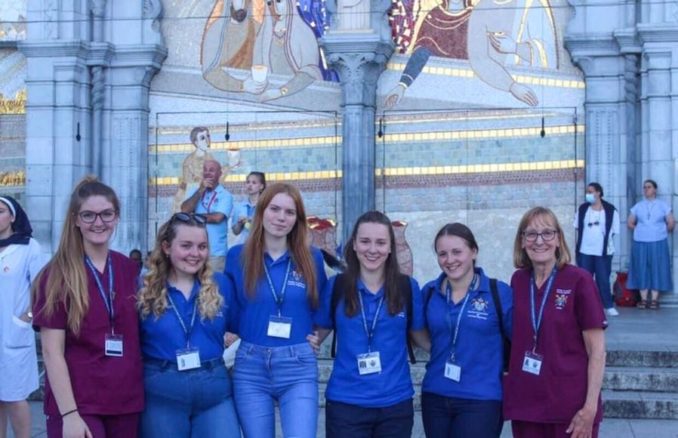
© Always Worth Saying 2022, Going Postal
© Always Worth Saying 2022



